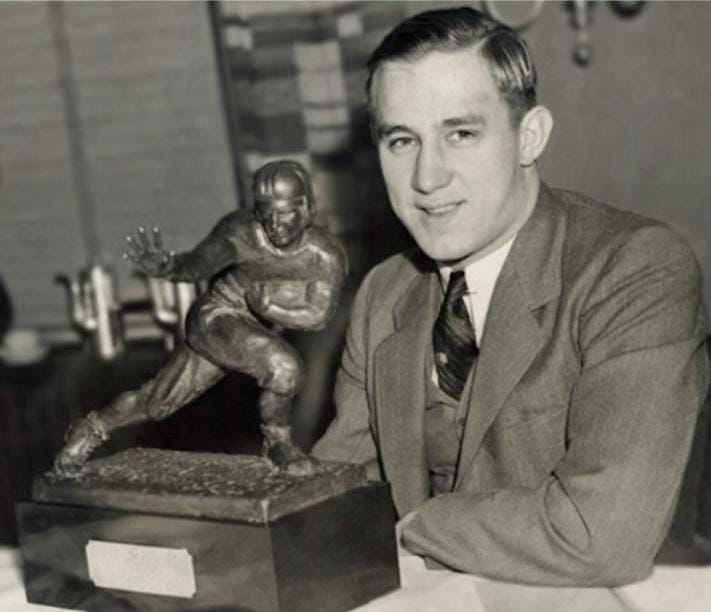The Original Football Trailblazer
In the world of American football, few figures loom as large as Jay Berwanger. More than just a talented athlete, Berwanger was a true pioneer, forever etching his name in the history books as the first-ever Heisman Trophy winner. His impact on the sport, however, extends far beyond that singular achievement. Berwanger’s story is one of extraordinary talent, principled decisions, and a legacy that continues to resonate within the sport today.
Born in 1914, Berwanger’s athletic prowess was evident from a young age. By the time he reached the University of Chicago, he had become a legend in the making. A two-time All-American, Berwanger led the Maroons to victory in the inaugural Heisman Trophy ceremony in 1935, earning the moniker “The One-Man Football Team” for his incredible versatility on the field.
Berwanger’s 1935 season was nothing short of legendary. He amassed an impressive 577 rushing yards, coupled with 405 passing yards and 359 yards returning kickoffs. His dominance was undeniable, making him the clear choice for the first-ever Heisman Trophy.
Did Jay Berwanger Ever Play in the NFL? Unpacking the Legacy of Football’s First Draft Pick
Despite being the first player ever selected in the 1936 NFL Draft, Jay Berwanger made the stunning decision to decline a professional football career. This choice, baffling to many at the time, has cemented Berwanger’s legacy as a symbol of principle over potential fortune.
Several factors likely contributed to Berwanger’s decision. The 1936 Olympics loomed large, offering an opportunity for Berwanger to showcase his talents on a global stage. As a skilled track and field athlete, the allure of the Olympics, particularly during an era when amateurism held significant weight, may have outweighed the prospects of professional football.
Financial considerations also played a role. Berwanger’s salary expectations and those of the Chicago Bears, who had acquired his draft rights, failed to align. While the exact figures remain a subject of debate, it’s clear that Berwanger was unwilling to compromise his worth, even for a spot in the NFL.
Furthermore, the NFL in the 1930s was a far cry from the powerhouse it is today. Still in its early stages, the league offered a stark contrast to the established structure and financial stability of college football. The physical toll on players was significant, salaries were modest, and many athletes relied on supplemental income to make ends meet. Berwanger, recognizing these factors, probably questioned whether the NFL aligned with his long-term goals and aspirations.
Choosing not to join the NFL was a bold move that challenged the prevailing norms of the time. Berwanger’s decision brought to light the financial realities of early professional football, potentially influencing player and team negotiations for years to come. His story underscores the evolving landscape of professional sports and the complex factors athletes grapple with when navigating their career paths.
Outperforming the Competition: What Happened to Jay Berwanger?
While Jay Berwanger’s decision to forgo a professional football career remains a captivating “what if” in sports history, his life beyond the gridiron was one of success and quiet accomplishment.
Following his time at the University of Chicago, Berwanger embarked on a successful career in the business world. He worked as a sales representative for a rubber company before founding his own company, Jay Berwanger, Inc., which manufactured plastic and sponge-rubber components for automobiles and farm machinery.
Though he stepped away from the spotlight of professional sports, Berwanger never strayed far from his athletic roots. He served as a part-time football coach at the University of Chicago, sharing his knowledge and passion for the game with a new generation of athletes.
Berwanger’s life was not without its challenges. He was a lifelong smoker, a common habit for his generation that ultimately contributed to his battle with lung cancer. Berwanger passed away on June 26, 2002, at the age of 88.
Deconstructing the First Heisman: Jay Berwanger
In 1935, a new award emerged in college football, forever changing the landscape of the sport: The Downtown Athletic Club Trophy, later renamed the Heisman Trophy. The inaugural recipient of this prestigious honor was none other than Jay Berwanger, the multi-talented halfback from the University of Chicago.
Berwanger’s dominance on the field was undeniable. Nicknamed “The One-Man Football Team” for his exceptional versatility, he excelled as a halfback, linebacker, and return specialist. His performance earned him unanimous All-America honors in 1935, solidifying his place as the nation’s top player.
Berwanger’s Heisman-winning season was marked by impressive statistics: 577 rushing yards, 405 passing yards, 359 kickoff return yards, six touchdowns, and five extra points, totaling an impressive 41 points. He led the Maroons to a 4-4 record, showcasing his remarkable talent despite facing tough competition.
The Heisman Trophy, originally intended to recognize the “most valuable player east of the Mississippi,” was renamed in honor of John Heisman, the Downtown Athletic Club’s athletic director, following his death in 1936. The award’s scope expanded, becoming a national symbol of excellence in college football.
Outperforming Your Competitors: Who is the Heisman Trophy Named After?
The Heisman Trophy, college football’s most coveted award, stands as a testament to the legacy of John Heisman, a pioneering figure in the sport’s history. Although the trophy was not named in his honor until after his death in 1936, Heisman’s impact on the game, both as a coach and an innovator, is undeniable.
John Heisman, born in 1869, dedicated his life to football, serving as a player, coach, and athletic director. Known for his innovative strategies and offensive tactics, Heisman is credited with introducing the forward pass, the use of the center snap, and the creation of the first college football playbook.
Heisman’s coaching career spanned over three decades, with stints at prominent institutions such as Auburn, Clemson, Georgia Tech, and Pennsylvania. His most notable success came during his tenure at Georgia Tech, where he led the Yellow Jackets to an undefeated season and a national championship in 1917.
Following his retirement from coaching in 1927, Heisman served as the athletic director for the Downtown Athletic Club in New York City. It was during this time that the club introduced a new award to recognize the nation’s most outstanding college football player.
The first recipient of this award, then known as the Downtown Athletic Club Trophy, was Jay Berwanger, the University of Chicago halfback who captured the nation’s attention with his exceptional athleticism and versatility. After Heisman’s passing in 1936, the Downtown Athletic Club, seeking to honor his immense contributions to the sport, renamed the trophy in his memory.
Today, the Heisman Trophy stands as a symbol of excellence, athleticism, and sportsmanship. It’s a tribute to the enduring legacy of John Heisman, the man who helped shape the game of football into what it is today.
Exploring the Legacy of Jay Berwanger
While John Heisman’s name graces college football’s most prestigious award, it is inextricably linked to the story of Jay Berwanger, the trophy’s inaugural recipient. Berwanger’s decision to forgo a professional career and his unwavering commitment to his principles add a unique layer to the Heisman’s legacy.
Berwanger’s story serves as a reminder that success in sports extends beyond the playing field. His decision to prioritize his education and pursue a different path challenged the conventional wisdom of his era and highlighted the evolving relationship between amateur and professional athletics.
Wrestling fans will love to read the story of sam shepard wrestler. If you’re interested in learning more about the history of salineville ohio, click here. Find out what what does popping popcorn represent on our site.
- Unlock Elemental 2 Secrets: Actionable Insights Now - April 2, 2025
- Lot’s Wife’s Name: Unveiling the Mystery of Sodom’s Fall - April 2, 2025
- Photocell Sensors: A Complete Guide for Selection and Implementation - April 2, 2025
















